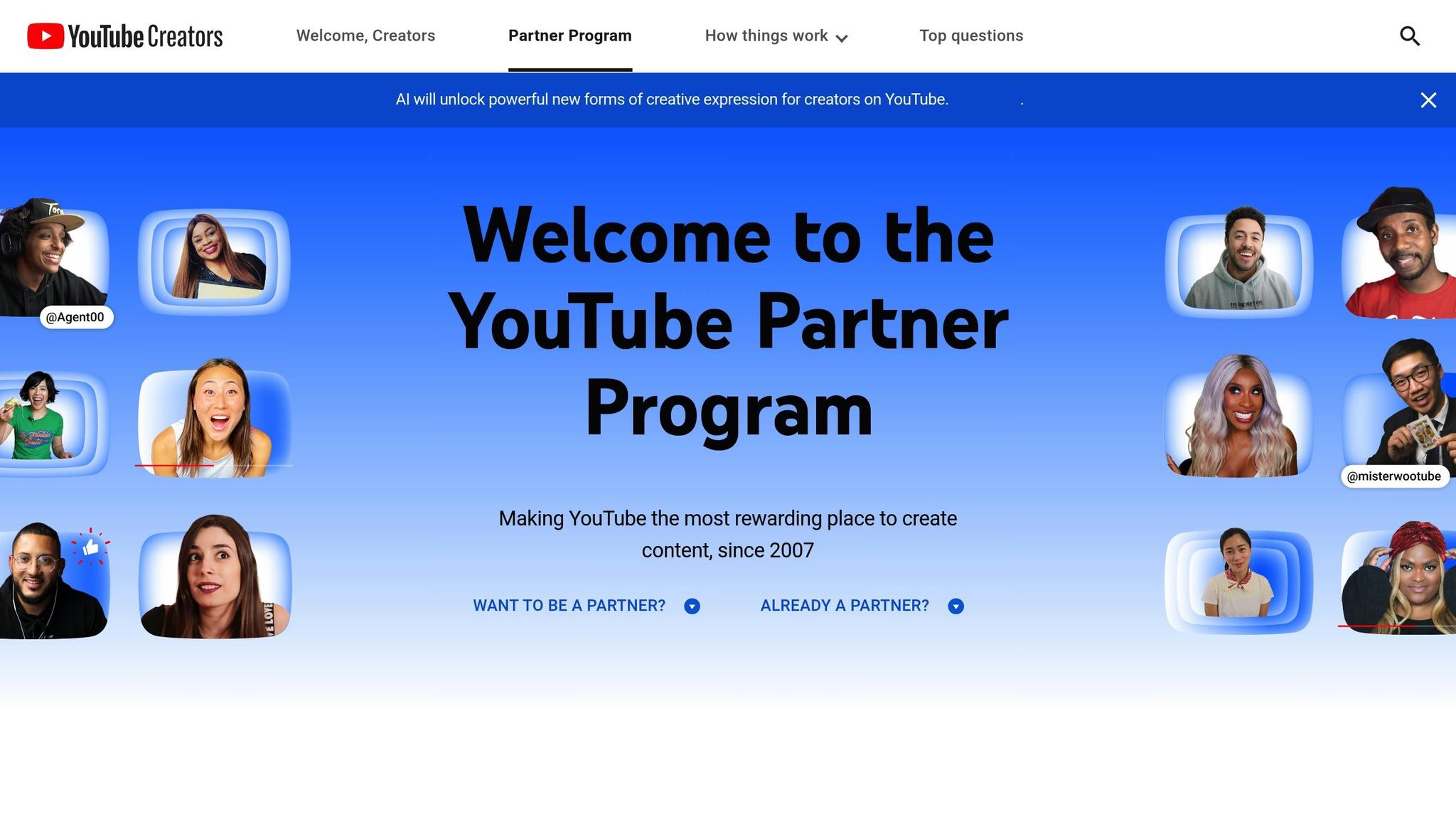How Much Do Youtubers Make?


( 1 )
YouTubers can earn anywhere from a few dollars to millions per month, depending on their channel size, niche, and monetization strategies. Here’s a quick summary of how they make money and what to expect:
- Ad Revenue: Creators earn about $0.018 per view or $18 per 1,000 views on average. For instance, 1 million views could bring in $1,500–$30,000.
- Sponsorships: Deals vary widely, but creators can earn $10–$50 per 1,000 views for sponsored content.
- Merchandise Sales: Engaged audiences can drive monthly merch earnings from $70 (small channels) to $3,000+ (mid-sized channels).
- Channel Memberships: Regular income from fans paying $4.99–$49.99/month for exclusive perks.
- Other Sources: Super Chats, Super Stickers, YouTube Premium revenue share, and affiliate marketing.
Earnings by Channel Size:
| Subscribers | Monthly Income Range |
|---|---|
| 1,000 | $50–$700 |
| 10,000 | $500–$1,500 |
| 100,000 | $5,000–$15,000 |
| 1,000,000+ | $50,000–$250,000 or more |
To maximize income, YouTubers focus on creating engaging content, diversifying income streams, and growing their audience. Even small channels can earn if they meet YouTube Partner Program requirements, like 1,000 subscribers and 4,000 watch hours in the last year.
YouTube Partner Program Basics

The YouTube Partner Program (YPP) allows creators to earn money from their content through various revenue streams. Here’s a breakdown of the qualifications and steps required to join.
How to Qualify for YPP
To become part of YPP, your channel must meet these key requirements:
- At least 1,000 subscribers
- 4,000 valid public watch hours in the last 12 months or 10 million valid public Shorts views in the past 90 days
- 2-Step Verification enabled on your Google account
- An active AdSense for YouTube account
- Access to advanced channel features
Keep in mind that YouTube may disable monetization for channels inactive for six months or more if no videos are uploaded or community engagement is maintained.
Content Guidelines
Your content must comply with YouTube’s rules, including:
- Following Community Guidelines and avoiding active strikes
- Ensuring your content respects copyright laws
- Making content suitable for advertisers
- Staying active by regularly uploading and engaging
- Adhering to YouTube’s Terms of Service
Steps to Join YPP
- Pre-Application Preparation
Verify your channel meets all eligibility requirements and review YouTube’s monetization policies. - Application Process
Log in to YouTube Studio, go to the ‘Earn’ section, click ‘Apply Now,’ accept the Base terms, and set up or link your AdSense for YouTube account. - Review Period
Once submitted, YouTube will review your channel for compliance, which typically takes about a month. If your application is denied, you can appeal within 21 days or reapply after 30 days (90 days for repeated rejections).
Main Ways YouTubers Make Money
YouTube Ads Income
Creators in the YouTube Partner Program earn 55% of the revenue from ads, while YouTube keeps 45%. Advertisers typically pay between $10 and $30 per 1,000 monetized views, which translates to about $0.018 per view for most creators. For example, 100,000 views could bring in $250 to $3,000, and 1,000,000 views might earn between $1,500 and $30,000. Additionally, revenue from YouTube Premium subscribers is shared based on how much watch time a creator’s content receives. Many creators also supplement this income with sponsorships.
Brand Deals and Sponsorships
Sponsorships are a major source of income for many YouTubers, with some earning up to 71% of their total revenue from brand partnerships. Common types of sponsorship deals include:
- Pre/Mid-roll Ads: These often have a CPM (cost per thousand impressions) ranging from $30 to $70.
- Dedicated Videos: Rates depend on audience engagement and can be significantly higher.
- Product Placement: Earnings vary based on the agreement.
To secure strong sponsorships, creators should prepare detailed media kits highlighting their channel metrics, be transparent with their audience about sponsored content, and use contracts to protect both parties.
Merchandise Sales
For channels with highly engaged audiences, merchandise sales can outperform ad revenue. For instance, a smaller channel with around 11,000 subscribers might make about $70 a month from merchandise. Channels with 50,000 monthly views could see earnings between $730 and $3,480 per month through merch sales.
Member Perks and Fan Support
Channel memberships provide consistent monthly income by offering perks like custom badges, emojis, exclusive content, members-only live chats, and behind-the-scenes access. To make the most of this, creators need to produce engaging content for their members and actively interact with them using YouTube’s community features. Promoting these benefits in videos can encourage more sign-ups and keep members satisfied.
Income by Channel Size
Earnings Under 100K Subscribers
Even smaller channels can start earning once monetized. For instance, channels with around 1,000 subscribers typically make between $50 and $700 per month, while those with about 10,000 subscribers might bring in $500 to $1,000 or more.
Here are some real-world examples that highlight how niche content affects earnings:
"My finance channel with 8,690 subscribers generates $666.30 monthly with a $22 RPM per 1,000 views." – Mikhaxl
"With my personal growth content, I earn $536.66 monthly at an $11 RPM per 1,000 views." – Irina Dee
Earnings from 100K-1M Subscribers
Once a channel surpasses 100K subscribers, income potential increases significantly. Mid-sized channels generally earn $500 to $1,500 per month, with some reaching $5,000 or more. However, earnings still depend heavily on the channel’s niche.
For example:
- Finance and tech channels often achieve RPMs of $15–$25.
- Gaming channels tend to average lower rates, around $4–$8 per 1,000 views.
- Channels targeting audiences in countries like the United States, United Kingdom, and Canada typically see higher ad revenue.
Earnings Above 1M Subscribers
At this level, channels often transform into full-fledged media businesses with multiple income streams. Monthly AdSense revenue alone can range from $10,000 to $100,000. Sponsored content becomes a major revenue driver, with rates between $10 and $50 per 1,000 views. Viral sponsored videos with over 1 million views can earn anywhere from $10,000 to $50,000. In 2022, the minimum price for a sponsored video exceeding one million views was approximately $2,500.
Creators also earn through channel memberships, which cost between $4.99 and $49.99 per member per month. However, YouTube takes a 30% cut from these fees.
At this stage, creators need to focus on diversifying their income, negotiating better sponsorship deals, and producing engaging, high-quality content to maintain and grow their audience.
Ways to Increase YouTube Income
Make Videos That Earn More
Plan your content with care. Topics like education, technology, and finance often attract higher ad revenue due to their appeal to valuable audiences and advertiser demand. Long-form videos that keep viewers engaged can also boost your earnings.
"Watch time is measured in cumulative minutes watched, and each video uploaded – as well as every channel on YouTube – is ‘ranked’ by watch time. Channels and videos with higher watch times are likely to show up higher in search results and recommendations." – YouTube Creator Academy
In addition to refining your content, expanding how you generate income can make a big difference.
Add More Income Sources
Don’t rely solely on ad revenue. You can monetize through options like channel memberships, merchandise, Super Chat and Stickers, affiliate marketing, and sponsored content. For sponsored content, ensure you follow advertising guidelines and aim for partnerships with brands that align with your channel’s focus.
While adding new revenue streams is important, growing your audience is just as vital.
Grow Your Viewer Base
Expanding your audience is key to increasing your income. Here are some effective strategies:
Optimize for Search and Discovery
- Use tools like KeywordTool.io to find low-competition keywords with high search volume.
- Design eye-catching custom thumbnails – 90% of top-performing videos use them.
- Write clear video descriptions with relevant keywords.
Boost Engagement
- Host live streams, reply to comments, and use the Community tab to interact with your audience.
- Create themed playlists to encourage viewers to watch multiple videos in one session.
Since YouTube’s algorithm accounts for 70% of viewer watch time, focus on creating content that keeps viewers coming back. Regularly check your analytics to see which videos resonate most with your audience and adjust your strategy accordingly.
Summary
Making money on YouTube involves careful planning and multiple income sources, which depend on the size of the channel and the type of content.
| Channel Size | Monthly Income Range |
|---|---|
| 1,000 subscribers | $50 – $100 |
| 10,000 subscribers | $500 – $1,500 |
| 100,000 subscribers | $5,000 – $15,000 |
| 1,000,000+ subscribers | $50,000 – $250,000 |
Earnings also vary by content type. For example, finance channels typically earn $12–$20 CPM, while entertainment channels earn around $2–$5 CPM. On average, creators earn about $18 for every 1,000 views. YouTube’s Partner Program has been a key driver of this success, paying creators over $50 billion in the past three years.
To maximize YouTube earnings, creators should focus on:
- Creating content that keeps viewers engaged
- Exploring multiple revenue streams, such as ads, memberships, merchandise, and sponsorships
- Improving search visibility to grow their audience
- Engaging consistently with their audience to build trust
- Using analytics to refine their strategy
Understanding where your audience is located also plays a role. For instance, views from countries like the USA, Australia, and Canada typically result in higher CPMs compared to regions with lower purchasing power. By combining these tactics with high-quality content and diverse income sources, creators can ensure steady growth and long-term success.






